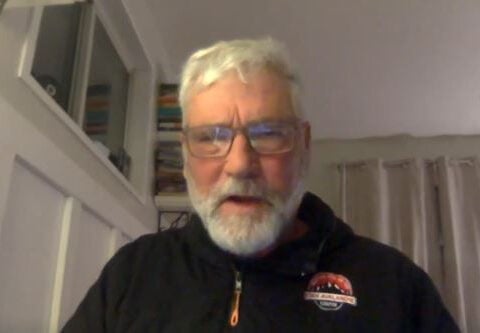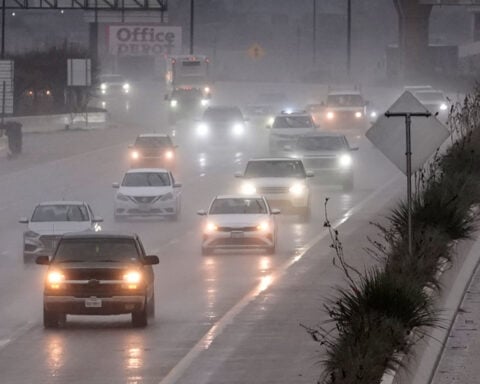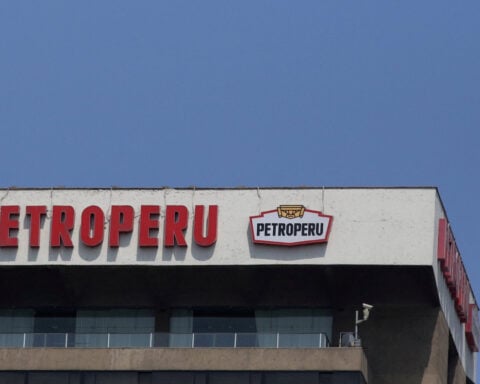EUREKA, Calif. (AP) — California Gov. Gavin Newsom is pledging to fast-track more than half a dozen projects by the end of his term to remove or bypass dams that have blocked salmon from returning to the state's chilly mountain streams and acting as the keystone of a complex ecosystem that sustains both economies and spiritual beliefs for tribes.
Newsom — now in his second term and seen as a potential Democratic presidential candidate beyond 2024 — has worked hard to stake a claim as the nation's most environmentally-conscious governor. But his record has been dogged by criticism from environmental groups who say his water policies benefit big agriculture at the expense of salmon and other species of fish in danger of becoming extinct.
Millions of salmon once filled California’s rivers and streams each year, bringing with them key nutrients from the ocean that gave the state an abundance of natural resources that were so important to indigenous peoples that they formed the foundation of creation stories central to tribes’ way of life.
But last year, there were so few salmon in the state's rivers that the officials closed the commercial fishing season.
Frustrated by the criticism leveled against him and his administration, Newsom on Tuesday released a plan outlining his strategy to protect salmon — a plan that includes a heavy helping of projects that would remove or bypass aging dams that prevent from returning to the streams of their birth to lay eggs.
“These are tangible. And so much of the work we do is, you know, you can’t see it, you can’t feel it,” Newsom told The Associated Press in an interview near the banks of the Elk River in Eureka near a recently completed project that returned some agricultural land to a flood plain habitat for salmon. “But when you see a dam being removed and you come back a few months later — a year or two, five years later — and you see real progress.”
Newsom’s salmon strategy includes a promise to complete an agreement by the end of the year to remove the Scott Dam and replace the Cape Horn Dam along the Eel River that have blocked salmon access to 288 miles (463 kilometers) of habitat. Once completed, the Eel would be the longest free-flowing river in the state, flowing north through the Coast Ranges before emptying into the Pacific Ocean near the town of Fortuna.
By next summer, Newsom said he would complete plans for the removal of the nearly 100-year-old Rindge Dam along Malibu Creek in western Los Angeles County that would give steelhead another 15 miles (24 kilometers) of spawning and rearing habitat. And by 2026 — the last year of Newsom’s term — he promised to complete the infrastructure necessary to remove the Matilija Dam in Ventura County along a tributary of the Ventura River.
These projects have already been announced and are in the early stages of development. Newsom’s plan, however, puts on record his goal to either complete them or have them approved by state regulatory bodies before he leaves office.
“I got three more years. And I want to put it all out there," Newsom said.
Newsom’s embrace of some dam demolitions comes as the largest dam removal project in U.S. history got underway in earnest last week when crews blew a hole in the bottom of the Copco No. 1 dam along the Klamath River near the California-Oregon border. It’s one of four dams set to be removed along the Klamath.
In addition to demolishing dams, Newsom is trying to bring attention to some of the $800 million he has signed off on in recent years for projects that return some creeks and streams to their natural state so that salmon can live there.
Monday, Newsom trudged through thick mud to visit a project along Prairie Creek in Redwoods National Park. The creek had been converted to a ditch, with steep rock walls preventing the water from spilling into a flood plain where baby salmon can eat and grow before heading out to the ocean. The goal is to get the baby fish to stay longer in this creek so they can grow larger before heading out to the ocean — making it more likely they will return.
Newsom watched as Kate Stonecypher, a graduate student at Cal Poly Humboldt, pulled juvenile coho salmon and steelhead trout from the river that had been tagged with a tracking device. Researchers are still studying the results. But early indications have been positive. Fish from the creek were later found to travel 50 miles (80 kilometers) to Humboldt Bay.
But the biggest criticism of Newsom's environmental policies have not been a lack of restoration projects, but a lack of water in the rivers. Newsom's salmon strategy includes a controversial proposal to seek voluntary agreements with major farmers over how much water they can take out of the rivers and streams. Some environmental groups, including the San Francisco Baykeeper, have called this plan “astonishingly weak.”
San Francisco Baykeeper Science Director Jon Rosenfield said California has already done lots of habitat restoration projects, but they have failed to result in significant boosts salmon populations.
“Without the essential ingredient of a river, which is the flow of water, fish ... are not going to survive," he said. “The governor is out there promising actions that are not adequate to restore the population."
He also pledged to continue to work with native tribes, who often refer to the rivers where salmon live as their church. Newsom formally apologized to Native American tribes four years ago for how the state had treated them historically. And he has committed to partnering with them to conduct much of the work around salmon habitat.
Monday, Frankie Myers, vice chair of the Yurok Tribe, told Newsom the tribe's work on Prairie Creek had changed the community by restoring the tribe's purpose.
“This goes beyond that apology. This is about restoration,” he said.

 Richard Parsons, prominent Black executive who led Time Warner and Citigroup, dies at 76
Richard Parsons, prominent Black executive who led Time Warner and Citigroup, dies at 76
 Judge says woman accusing Jay-Z, Sean 'Diddy' Combs of raping her at age 13 can proceed anonymously
Judge says woman accusing Jay-Z, Sean 'Diddy' Combs of raping her at age 13 can proceed anonymously
 Bird flu virus shows mutations in first severe human case in US, CDC says
Bird flu virus shows mutations in first severe human case in US, CDC says
 Interest rate path to determine if Aussie banks can sustain rich valuations in 2025
Interest rate path to determine if Aussie banks can sustain rich valuations in 2025
 South Korea's acting president faces impeachment vote as court meets on martial law case
South Korea's acting president faces impeachment vote as court meets on martial law case
 FDA proposes new testing rules to ensure cosmetics are asbestos-free
FDA proposes new testing rules to ensure cosmetics are asbestos-free
 Richard Parsons, American media and finance troubleshooter, dies at 76
Richard Parsons, American media and finance troubleshooter, dies at 76








